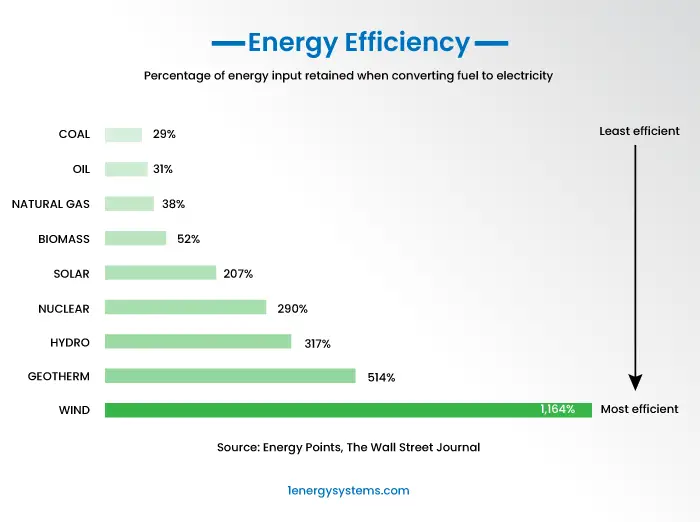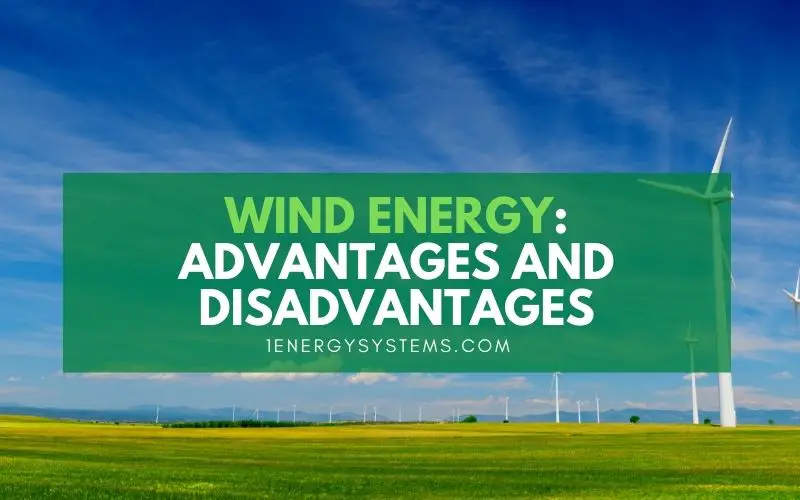Wind energy is the most efficient among all renewable energy resources. Clean, green, sustainable, and renewable, wind power is the fastest-growing energy source.
How does wind energy work?
As long as the sun is shining and heating the land, water, and atmosphere unevenly, the wind will blow. All we need to do is to have the equipment and technology to harness the power of the wind. Therein lie the advantages and the challenges.
There is no dispute about the efficiency or sustainability of wind power technology. All its challenges are equipment-related. At various stages of manufacture, transportation, installation, operation, and maintenance, the wind turbines and the rest of the equipment used in the generation of wind energy meddle with the ecosystem, harm the environment, and emit greenhouse gasses resulting in global warming and climate change.
This article takes a comprehensive look at the benefits and wind power disadvantages.
Pros and cons of wind energy
Nothing in this world comes with only advantages. As they say, there are two sides to a coin, even the best of things will have some flaws. This rule applies to wind energy as well.
First, let’s take a look at the gains of wind power.
Advantages of wind energy
1. It is free.
As the fuel used in the working of the wind turbine is just wind and wind alone, there is no expense involved on this account. The wind that is already blowing turns the turbine, resulting in the production of electricity. This is in stark contrast with a coal-powered power plant in which coal needs to be purchased, transported, and stored.
Once the wind turbine and accompanying installation are set up, there is no need for any input or human intervention. The installation will continue to generate electricity as the wind blows and turns the turbines.
2. It is the cleanest energy source.
Unlike fossil fuels, there is no burning involved in energy generation using wind power. As wind rotates the turbines, the wind installation produces electricity. No greenhouse gas emissions are involved. Nor is there any chance of air pollution.
The operation of a wind installation is clean and environment-friendly. However, the same cannot be said about the equipment itself. The manufacture, transportation, installation, and even maintenance of wind turbines give rise to unavoidable carbon emissions. As newer technologies are being developed, efforts are being made to reduce the carbon footprints of wind turbines.
3. It is renewable and sustainable.
The wind blows all the time whether we are harnessing it to generate electricity or not. As the sun heats various components on the earth’s surface differently, it results in wind. As we use the wind blowing today to produce electricity, it doesn’t affect the strength of the wind that will blow tomorrow. This means wind power is a renewable energy source.
Sustainability means using something today without affecting its availability in the same measure for future generations. As harnessing wind power doesn’t affect its availability tomorrow or years later, it can be safely said that wind energy is sustainable.
4. It has the highest conversion rate.

Conversion rate or energy efficiency refers to the percentage of electricity generated using the input energy, here it is wind energy. Among all the renewable and non-renewable energy sources, wind power tops the table with an 1164% conversion efficiency.
This means wind power creates 1164% of its original energy input. In efficiency, wind energy is way ahead of the pack with geothermal coming a distant second at 514%. The least efficient are coal (29%) and oil (31%) as most of the energy contained in them gets lost as heat energy at the time of burning to generate electricity.
5. It can share the landscape.
Wind turbines can coexist with crops on farmland or ranches. As they need to be set up at some distance apart, the remaining landscape can be used for farming or grazing purposes. This is one clear advantage wind turbines have over solar panels. The latter takes up the entire space. Wind turbines don’t disrupt farming or ranching activities in any way.
Setting up wind turbines is a good income generation opportunity for farmers and ranchers. Especially on poorly-irrigated farmland, during drought years, having wind turbines offers them a steady stream of income. Usually, energy companies enter into a contract or lease to use the farmland for wind turbine installation.
Related: Negative Effects of Wind Turbines on the Environment
6. It has made big strides in technology.
We have come a long way since the use of wind energy in sailboats and grinding flours centuries ago. Now, with the added emphasis on renewable energy, wind power is getting a lot of attention. Newer technologies are coming up, raising the efficiency of the equipment and reducing the negative impacts,
Today, wind turbines are available for large-scale energy production in wind farms as well as for individual use. The advancements in technology are helping reduce the maintenance requirements and raising the safety aspects of wind turbines.
7. It reduces our dependence on fossil fuels.
As we all know, fossil fuels are wreaking havoc on our planet, with more carbon emissions and atmospheric pollution. Unless we develop a technology that is as convenient and user-friendly as fossil fuel-powered power generation, despite being aware of the dangers involved, we will continue to stick with fossil fuels.
Moreover, the known deposits of fossil fuels are limited. At the present rate of use, we will run out of them in a few decades from now. This is the reason for the urgency to find an alternative. And wind energy fits the bill perfectly as it ticks all the boxes.
Disadvantages of wind energy
1. It has a high upfront cost.
The wind turbines and other equipment required to harness wind energy and generate electricity don’t come cheap. These massive structures are expensive. Setting up a wind energy installation involves a substantial initial investment. More so for offshore wind energy installations.
Using wind power for utility-scale power generation involves more investment in laying underground cables to transfer the electricity generated to the nearest power station. However, most of the expenditure involved is restricted to the initial stage. Once the arrangement is in place, there is minimal expenditure. Even the maintenance requirements for wind installations are limited.
2. It poses a threat to wildlife.
As wind turbines have blades moving all the time, unlike solar power, they may cause harm to animals, birds, and marine life. The positioning of wind turbines may disrupt the habitats and migratory paths of various members of the animal kingdom. Birds may fly into the rotating turbines unawares, injuring or killing them.
Deaths of birds is a serious issue that has no solution as of now. However, the same threat is posed by skyscrapers as well. More work needs to be done to avoid such happenings. Besides the threat of spinning blades, noise pollution is another problem for both animals and humans.
3. It creates noise pollution.
Unlike solar panels, wind turbines have moving blades. This means they make a whirring sound whenever the blade is turning. The whirring sound of the turbines can be highly upsetting for all life in the vicinity, affecting their mental as well as physical health.
Scientists who have studied the detrimental effects of this constant noise pollution have discovered that this low yet continuous sound can disturb all living beings alike. This can affect their sleep pattern and circadian rhythm. This will have a tumbling effect on the health and wellbeing of those affected.
Even offshore wind installations can create disturbance to marine creatures. With newer advancements in technology, the emphasis is on bringing down the noise levels of turbines.
4. It is not reliable or predictable.
It is hard to predict when the wind will blow. Unless the wind blows, the installation cannot generate electricity. This means the wind installation is at the complete mercy of the wind. And, that makes wind energy unreliable and unpredictable.
Even when the wind is blowing, it may blow at different speeds and strengths. This again means that there will be fluctuation in energy production. Wind energy cannot be relied upon as the sole energy source for an uninterrupted power supply. This necessitates an energy reserve or backup energy source to take on the load when the wind is not blowing and the installation is generating less or no electricity.
5. It is a blot on the landscape.
Or seascape for an offshore wind installation. Wind turbines are massive structures, hundreds of feet tall so that they can capture the blowing wind effectively. Though they do a good job on the efficiency front, the sight of these huge fan-like structures dotting the landscape is not appealing.
As most often wind farms are located in remote parts of the land, these tall massive structures can disturb the scenic landscapes. It would be all the more disrupting when the wind farm is located on virgin forestland with mountain ranges, rivers, and lakes forming the backdrop. Unfortunately, there is not much that can be done about it.
Bottom line
Wind energy is cost-effective, has low operating costs, creates jobs, and helps in making countries self-reliant on the energy front. On the other hand, the environmental impact of wind power cannot be ignored. Setting up wind installations may not be the most profitable way to use the land space.
The need of the hour is the development of newer technologies with the focus on lowering the cost, improving reliability, and raising energy efficiency. Regional deployment issues need to be resolved, the resource area needs to be expanded, and infrastructure and manufacturing facilities need to be developed further. Minimizing the environmental impact is to be afforded high priority.
Large-scale deployment of wind energy such as wind farms may be postponed so that technological advancements have a chance to catch up with the demands.
Related:

